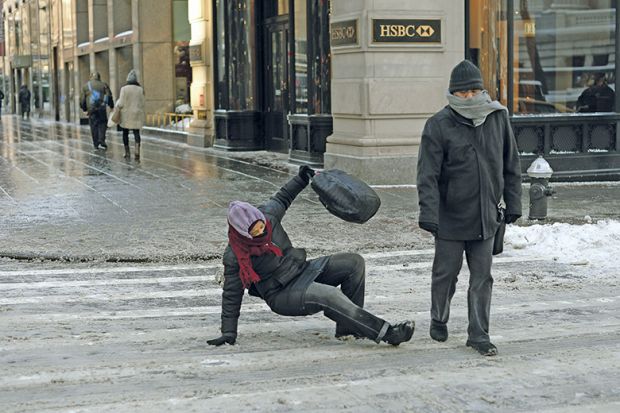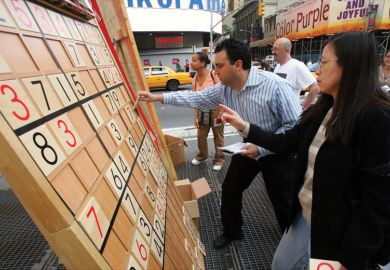Recent reports have raised concerns over university dropout rates for “low participation” students. Social mobility efforts as a whole came under heavy criticism in last month’s Social Mobility Commission report, and as universities struggle along with their widening participation initiatives, pressure is growing for institutions to take more drastic action.
Increasingly, this translates into making lower tariff points offers to undergraduate applicants from disadvantaged or low participation backgrounds. In December, one institution announced a controversial commitment to guarantee lower offers to five “high potential” students in every school in the local area. These measures are going to fail many of the individuals whom they aim to support.
In his book David & Goliath, Malcolm Gladwell reports some surprising trends based on dropout rate statistics in American higher education (it’s in chapter three, if you’re looking). The data show that dropout rates are driven more by a student’s ranking within their class than by their actual ability: remarkably, a bottom quartile Harvard student is much more likely to quit their course than a high-ranking student in a lesser university, even where the Harvard student is demonstrably academically stronger than their lesser counterpart.
Data show that this disparity is even wider for students eligible for affirmative action programmes (the US equivalent of widening participation or positive discrimination), which habitually entail setting lower academic requirements for entry for students from disadvantaged backgrounds.
Gladwell’s explanation of the data is that students primarily compare themselves to their class peers and experience a poor relative performance as demoralising and demotivating, regardless of their objective ability. Affirmative action students will generally all be in higher-standard institutions than their grades would have otherwise qualified them for. As a consequence, they are likely to be among the lower academic performers in their class and so are more likely to drop out than other students.
In the institutions they would have joined based on normal entrance requirements, they would have been higher ranked relative to their classmates and so have been more likely to complete their studies.
Gladwell goes further to argue that you would, according to the statistics, help a student more by moving them into a weaker institution where they would be a high-flyer, although I doubt that any of us have the appetite for pushing disadvantaged students into worse institutions than their grades merit.
To avoid misunderstanding, there is no suggestion that students from disadvantaged backgrounds are necessarily inherently less capable than their peers: however, because of the affirmative action programme, all but the very best will have the opportunity to “trade up” into a “tougher” institution than they could otherwise have accessed.
While the “10,000 hours of practice” concept from Gladwell’s book Outliers has become close to ubiquitous among those concerned with sporting and academic performance (despite a bit of a misrepresentation by Gladwell of the study on which it is based), his affirmative action argument does not seem to have caught on in the same way. However, its statistical basis and potential to improve student outcomes suggest that it too might have value and deserve to gain traction.
In the UK, efforts to widen participation in HE have primarily focused on outreach activities and funding for scholarships, fee waivers, and bursaries. The application of reduced academic requirements for “low participation” students has historically been limited (skirting tactfully around the thorny topic of recognition of alternative forms of prior learning), but data show that the practice is increasing. Surveys performed by the organisation Supporting Professionalism in Admissions (on higher education institutions and further education institutions with HE offerings) indicate that from 2011 to 2015, the proportion of institutions using applicants’ “contextual data” to make lower points offers to particular individuals increased from 18 per cent to 37 per cent.
Current pressure on widening participation is likely to accelerate this rate of growth.
Lower points offers shouldn’t be viewed as an unmitigated failure. While they may raise dropout rates, per Hesa’s latest statistics, 91.2 per cent of young students from “low participation neighbourhoods” do progress to at least the second year of their course, and some of these individuals may not have been at university but for their reduced offer. In future, big data analytics may also help to reduce dropout rates by identifying early indicators that a student may be at risk of dropping out and so allowing intervention to address any problems that they are experiencing.
Notwithstanding these positives, instead of setting students up to struggle (relative to all their immediate peers), get demoralised and fail, if universities cooperate to leverage the range of academic standards offered by a group of institutions and get students into the right course at the right university, we can set up our students to participate with their peers feeling like academic equals, to build confidence, and ultimately, to succeed.
At least until the government prices the poor out of higher education and forces the working classes to do apprenticeships in the trades instead.
Huw Owen is a tax accountant at the University of Leeds.
Register to continue
Why register?
- Registration is free and only takes a moment
- Once registered, you can read 3 articles a month
- Sign up for our newsletter
Subscribe
Or subscribe for unlimited access to:
- Unlimited access to news, views, insights & reviews
- Digital editions
- Digital access to THE’s university and college rankings analysis
Already registered or a current subscriber?









